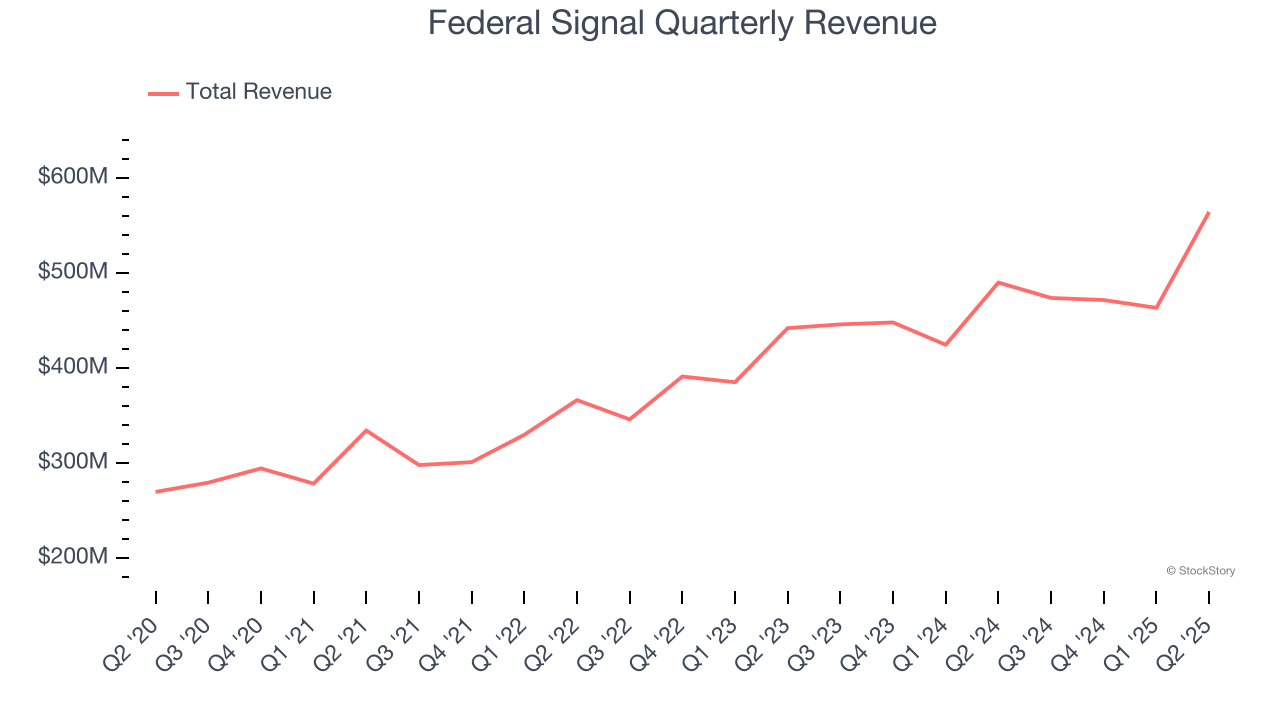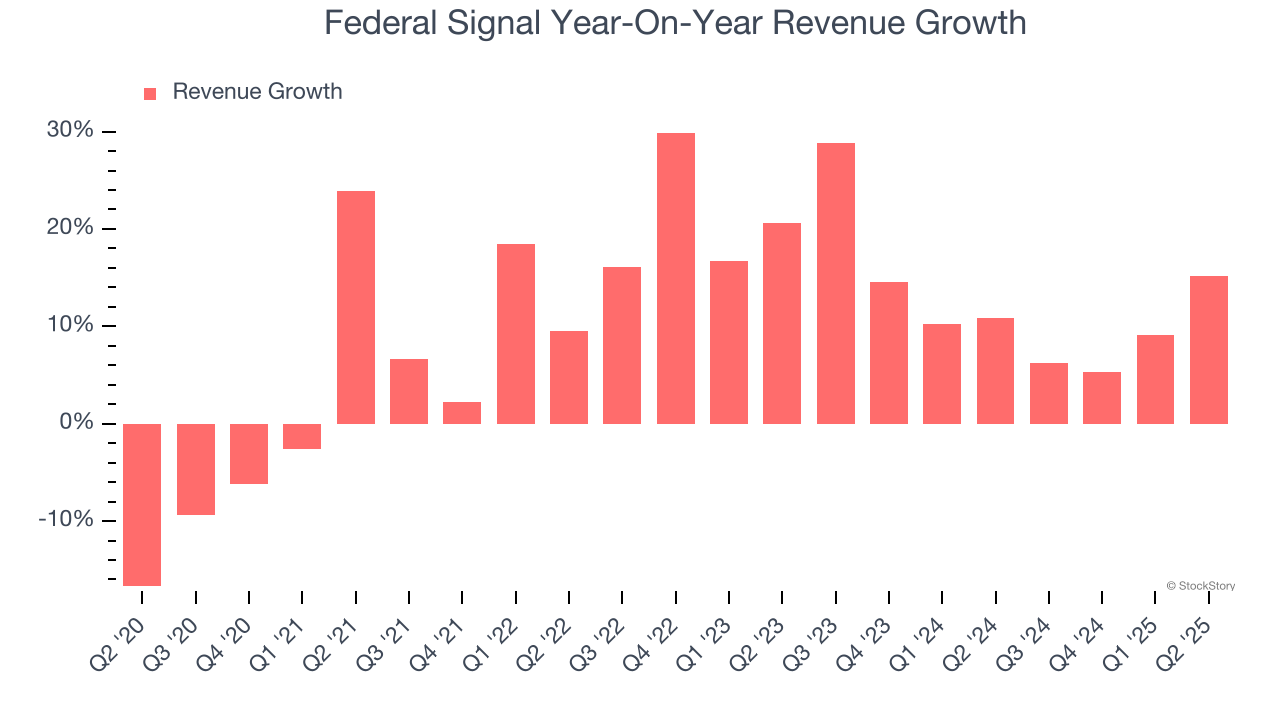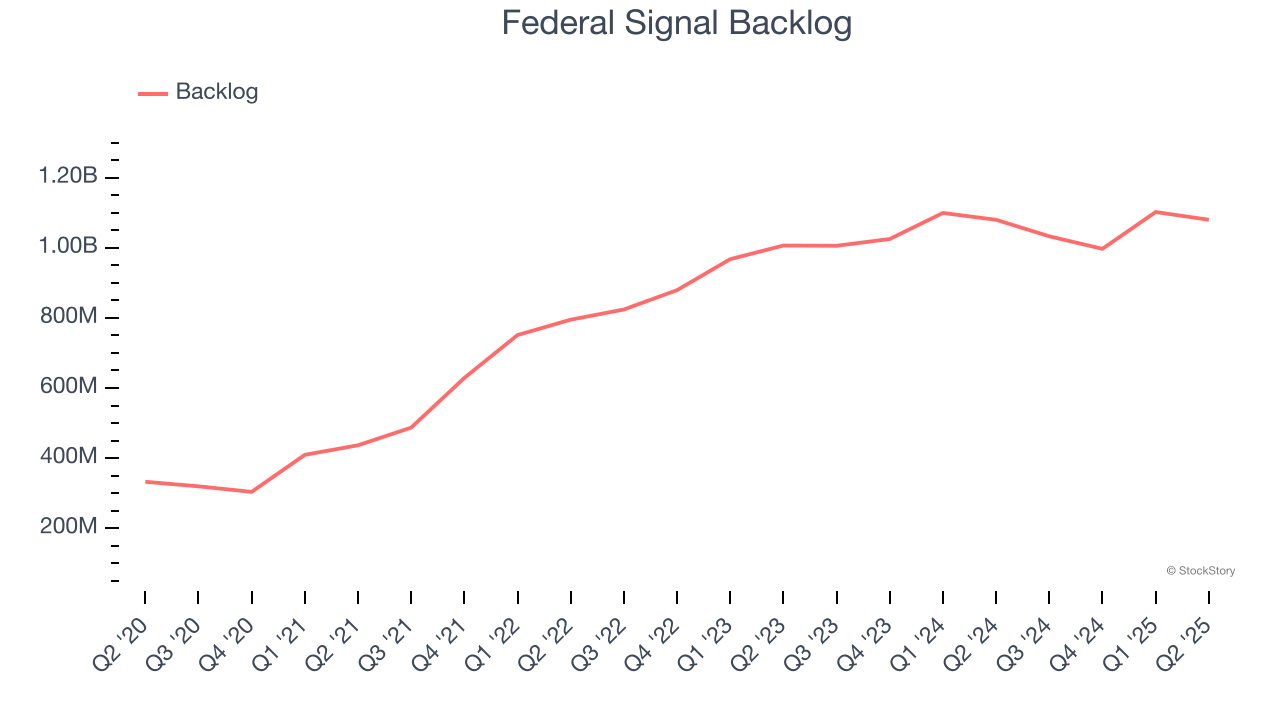
Safety and security company Federal Signal (NYSE: FSS) beat Wall Street’s revenue expectations in Q2 CY2025, with sales up 15.1% year on year to $564.6 million. The company’s full-year revenue guidance of $2.1 billion at the midpoint came in 2.2% above analysts’ estimates. Its non-GAAP profit of $1.17 per share was 10.5% above analysts’ consensus estimates.
Is now the time to buy Federal Signal? Find out by accessing our full research report, it’s free.
Federal Signal (FSS) Q2 CY2025 Highlights:
- Revenue: $564.6 million vs analyst estimates of $536.8 million (15.1% year-on-year growth, 5.2% beat)
- Adjusted EPS: $1.17 vs analyst estimates of $1.06 (10.5% beat)
- Adjusted EBITDA: $118.2 million vs analyst estimates of $110.4 million (20.9% margin, 7.1% beat)
- The company lifted its revenue guidance for the full year to $2.1 billion at the midpoint from $2.06 billion, a 1.9% increase
- Management raised its full-year Adjusted EPS guidance to $4.01 at the midpoint, a 6.5% increase
- Operating Margin: 17.3%, in line with the same quarter last year
- Free Cash Flow Margin: 9.3%, up from 5.1% in the same quarter last year
- Backlog: $1.08 billion at quarter end, in line with the same quarter last year
- Market Capitalization: $6.36 billion
"In what is typically a seasonally-strong period, our businesses were able to deliver 15% year-over-year net sales growth, 20% operating income improvement, gross margin expansion, and a 100-basis point increase in adjusted EBITDA margin during a record-setting second quarter," commented Jennifer L. Sherman, President and Chief Executive Officer.
Company Overview
Developing sirens that warned of air raid attacks or fallout during the Cold War, Federal Signal (NYSE: FSS) provides safety and emergency equipment for government agencies, municipalities, and industrial companies.
Revenue Growth
Reviewing a company’s long-term sales performance reveals insights into its quality. Any business can put up a good quarter or two, but the best consistently grow over the long haul. Thankfully, Federal Signal’s 10.9% annualized revenue growth over the last five years was impressive. Its growth surpassed the average industrials company and shows its offerings resonate with customers, a great starting point for our analysis.

We at StockStory place the most emphasis on long-term growth, but within industrials, a half-decade historical view may miss cycles, industry trends, or a company capitalizing on catalysts such as a new contract win or a successful product line. Federal Signal’s annualized revenue growth of 12.3% over the last two years is above its five-year trend, suggesting its demand was strong and recently accelerated. Federal Signal’s recent performance shows it’s one of the better Heavy Transportation Equipment businesses as many of its peers faced declining sales because of cyclical headwinds. 
Federal Signal also reports its backlog, or the value of its outstanding orders that have not yet been executed or delivered. Federal Signal’s backlog reached $1.08 billion in the latest quarter and averaged 7.5% year-on-year growth over the last two years. Because this number is lower than its revenue growth, we can see the company fulfilled orders at a faster rate than it added new orders to the backlog. This implies Federal Signal was operating efficiently but raises questions about the health of its sales pipeline. 
This quarter, Federal Signal reported year-on-year revenue growth of 15.1%, and its $564.6 million of revenue exceeded Wall Street’s estimates by 5.2%.
Looking ahead, sell-side analysts expect revenue to grow 7.3% over the next 12 months, a deceleration versus the last two years. This projection doesn't excite us and implies its products and services will see some demand headwinds. At least the company is tracking well in other measures of financial health.
Today’s young investors won’t have read the timeless lessons in Gorilla Game: Picking Winners In High Technology because it was written more than 20 years ago when Microsoft and Apple were first establishing their supremacy. But if we apply the same principles, then enterprise software stocks leveraging their own generative AI capabilities may well be the Gorillas of the future. So, in that spirit, we are excited to present our Special Free Report on a profitable, fast-growing enterprise software stock that is already riding the automation wave and looking to catch the generative AI next.
Operating Margin
Operating margin is a key measure of profitability. Think of it as net income - the bottom line - excluding the impact of taxes and interest on debt, which are less connected to business fundamentals.
Federal Signal has been an efficient company over the last five years. It was one of the more profitable businesses in the industrials sector, boasting an average operating margin of 13.1%. This result was particularly impressive because of its low gross margin, which is mostly a factor of what it sells and takes huge shifts to move meaningfully. Companies have more control over their operating margins, and it’s a show of well-managed operations if they’re high when gross margins are low.
Looking at the trend in its profitability, Federal Signal’s operating margin rose by 4.4 percentage points over the last five years, as its sales growth gave it operating leverage.

This quarter, Federal Signal generated an operating margin profit margin of 17.3%, in line with the same quarter last year. This indicates the company’s cost structure has recently been stable.
Earnings Per Share
We track the long-term change in earnings per share (EPS) for the same reason as long-term revenue growth. Compared to revenue, however, EPS highlights whether a company’s growth is profitable.
Federal Signal’s EPS grew at a spectacular 15.9% compounded annual growth rate over the last five years, higher than its 10.9% annualized revenue growth. This tells us the company became more profitable on a per-share basis as it expanded.

Diving into the nuances of Federal Signal’s earnings can give us a better understanding of its performance. As we mentioned earlier, Federal Signal’s operating margin was flat this quarter but expanded by 4.4 percentage points over the last five years. This was the most relevant factor (aside from the revenue impact) behind its higher earnings; interest expenses and taxes can also affect EPS but don’t tell us as much about a company’s fundamentals.
Like with revenue, we analyze EPS over a more recent period because it can provide insight into an emerging theme or development for the business.
For Federal Signal, its two-year annual EPS growth of 28.5% was higher than its five-year trend. We love it when earnings growth accelerates, especially when it accelerates off an already high base.
In Q2, Federal Signal reported EPS at $1.17, up from $0.95 in the same quarter last year. This print easily cleared analysts’ estimates, and shareholders should be content with the results. Over the next 12 months, Wall Street expects Federal Signal’s full-year EPS of $3.68 to grow 10.2%.
Key Takeaways from Federal Signal’s Q2 Results
We were impressed by how significantly Federal Signal blew past analysts’ revenue expectations this quarter. We were also glad its full-year EPS guidance trumped Wall Street’s estimates. Zooming out, we think this quarter featured some important positives. The stock traded up 5.9% to $111 immediately following the results.
Indeed, Federal Signal had a rock-solid quarterly earnings result, but is this stock a good investment here? We think that the latest quarter is only one piece of the longer-term business quality puzzle. Quality, when combined with valuation, can help determine if the stock is a buy. We cover that in our actionable full research report which you can read here, it’s free.





